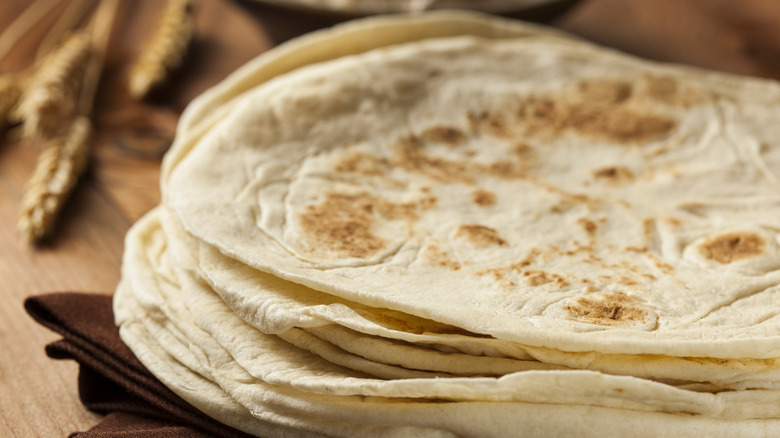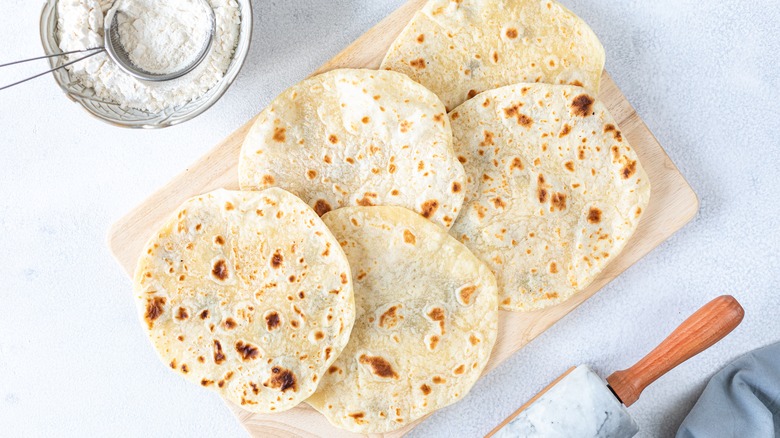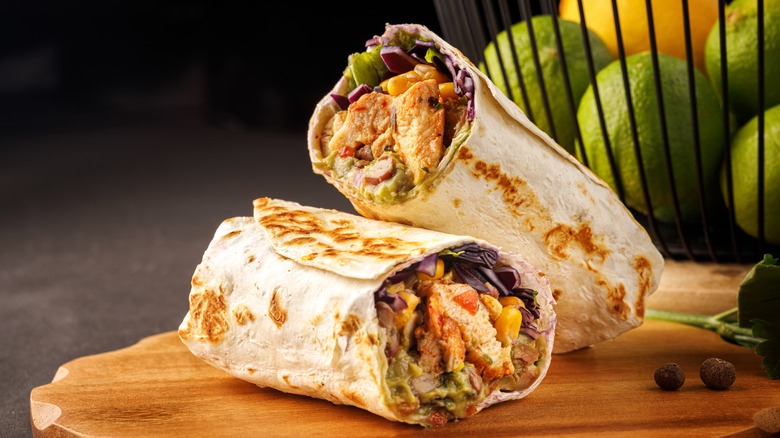The Key To Making Restaurant-Quality Flour Tortillas
While it may be incredibly convenient to purchase pre-made flour tortillas at the grocery store, no brand can beat the delectable taste of homemade wraps. When made fresh, tortillas can carry a savory undertone as well as a pillowy texture that humans have enjoyed as far back as the 1600s, a time when Spanish colonizers began to use wheat as a replacement for corn in Mexico.
Luckily for the modern-day home cook, the recipe has remained relatively simple over time, but there are a few missteps that could be keeping you from making the tastiest burritos or quesadillas. In fact, the biggest mistake you'll want to avoid when making homemade flour tortillas is skipping on the lard when making the dough.
Mexican cuisine traditionally utilizes lard as the leading fat substance for a variety of dishes such as refried beans and tamales, and tortillas are no exception. When added to a dough, this ingredient helps create a savory taste and lighter texture in the final product. Once you shape your dough into a tortilla and place it on a hot griddle or pan, the lard will also help it toast up more evenly, as fats are more capable of browning than just a combination of wheat flour and water.
Flour tortillas shine best with a dash of sugar
Preparing homemade tortillas starts with making the dough, which simply consists of wheat flour, water, lard, and a pinch of salt. You can start incorporating the lard right after you've mixed all of your powdery ingredients together. From there, you can add water to the batter until you've reached your desired consistency, and then shape the tortillas (either by hand or a press) and cook them in a hot griddle.
Many kinds of lard tend to have a flavor reminiscent of pork, which can overpower the taste of your dough with rich overtones. When shopping for lard, try to avoid varieties made with the kidney fat of a pig or those that have been rendered and processed, as these will have a stronger overall flavor profile.
If you have a particularly potent lard, sugar can help mask this, as sweets are one of the two flavors that can counteract the heaviness of various dairy and meat ingredients. Since you're not trying to end up with a sweet pastry, you should only use about a teaspoon or less in your recipe. Brewing some tomatillo water can help you get pillowy soft tortillas as well, and give your tortilla batter enough tang to cut through any wanted flavors of lard.
When to use flour tortillas vs. corn
While the debate on whether and when to use flour vs corn tortillas remains divisive at best, many people agree that burritos, fajitas, and quesadillas are typically the dishes where the wheat ingredient works best. Their large size and malleable texture can be folded to the shape of a wrap without snapping in half, making them an excellent choice over corn tortillas. In fact, flour options are so flexible that you can use a ramekin to shape them into taco bowl shells, which will crisp up excellently in the oven and can withstand a heavy spoonful of fillings.
On the other hand, corn tortillas work best in dishes where their strong flavor either shines as a leading ingredient or when masked in flavorful sauces. Tacos and enchiladas are typically the recipes where you should use this ingredient, although corn tortillas also shine when fried into chips or taquitos as well. Making homemade corn tortillas is almost identical to making flour ones as well, and you can still use lard in the dough to make them taste richer and fluffier.



